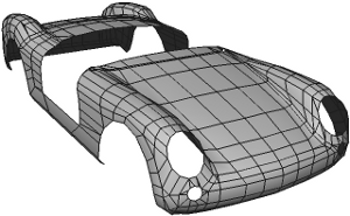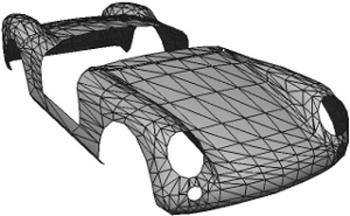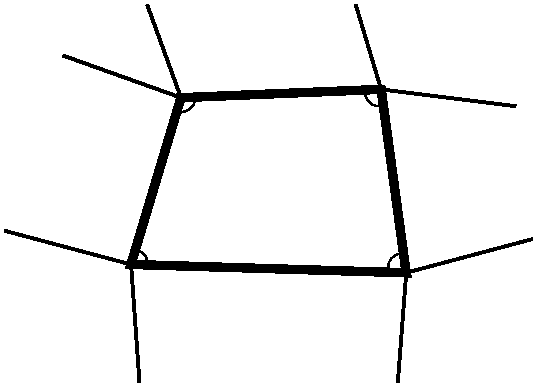Quadrangulation and triangulation convert between polygons with different numbers of edges:
Quadrangulation dissolves pairs of adjacent triangles to form quads.
Triangulation subdivides quads and polygons with five or more sides to form triangles.
You can use these commands when you require polygons with a specific number of sides, for example, when converting between formats for different 3D software or for use in a game engine.
Quadrangulation dissolves pairs of adjacent triangles to form quadrilateral polygons, according to rule-based criteria. This is useful for cleaning up imported quad objects that were converted to triangles. It can also be useful as a first step when turning any arbitrary triangle mesh into quads, although the modified mesh may still contain some triangles.

|

|
Select one or more polygon mesh objects, polygon clusters, or polygons.
Choose Modify  Poly. Mesh
Poly. Mesh  Quadrangulate. The Quadrangulate Op property editor opens.
Quadrangulate. The Quadrangulate Op property editor opens.
Set the parameters as desired:
Incidence Angle controls the sharpness of edges that can be dissolved. See Adjusting the Incidence Angle.
The Aspect parameters define several additional tests for eliminating pairs of triangles from consideration. See Setting the Aspect Tests.
The Attributes Preservation parameters control whether attributes like hard edges are preserved in the modified mesh. See Preserving Attributes.
As you adjust values, Nb Polygons indicates the total number of polygons in the modified mesh object. This number depends on the other settings and is displayed for information only.
Incidence Angle controls the sharpness of edges that can be dissolved. The value is the maximum difference between the normals of two adjacent triangles at which they are considered as candidates for dissolving.
For example, if this value is 30, then only adjacent triangles with dihedral angles between 30 and -30 degrees are considered. As you increase this value, you start to lose more sharp details.

Flatter edges are dissolved (A), but sharper edges are not (B).
The Aspect parameters define several additional tests for eliminating pairs of triangles from consideration as candidates for dissolving. First, the polygons are optionally projected onto a plane. Then, when a pair of triangles is considered, the potential resulting quad is tested to see:
You can use both of these rules in conjunction to control the quadrangulation. For example, set Max Alignment Angle to its maximum value while you gradually increase Max Corner Right Angle Deviation; more pairs of triangles get dissolved but the resulting quads may be poorly aligned. Next start decreasing Max Alignment Angle to make the alignment rule stricter. Continue to adjust both sliders to get the best possible result.
Projection Plane specifies the projection plane used for the tests.
For example, if your mesh object is a terrain model that looks like regular triangles in the Top view, set Projection Plane to XoZ Plane.
Test Corner Angle tests the corners of the resulting quad. If they differ from 90 degrees by more than Max Corner Right Angle Deviation, the pair of triangles is eliminated as a candidate for dissolving.
Decreasing Max Corner Right Angle Deviation results in more rectangular quads but more leftover triangles.

Test Quad Alignment tests the alignment of the quad's edges with the edges of its neighboring polygons. If the angle between edges differs from a straight line by more than Max Alignment Angle, the pair of triangles is eliminated as a candidate for dissolving.
Decreasing Max Alignment Angle results in better aligned quads but more leftover triangles.

Triangulation subdivides polygons with four or more edges into triangles. Existing triangles are not affected.
Select one or more polygon mesh objects, polygon clusters, or polygons.
Choose Modify  Poly. Mesh
Poly. Mesh  Triangulate.
Triangulate.
This command actually applies a SubdividePolygon operator with Subdivision Type set to Triangles, but it does not automatically open the property editor.
For more information about the SubdividePolygon operator, see Subdividing Polygons and Edges.
 Except where otherwise noted, this work is licensed under a Creative Commons Attribution-NonCommercial-ShareAlike 3.0 Unported License
Except where otherwise noted, this work is licensed under a Creative Commons Attribution-NonCommercial-ShareAlike 3.0 Unported License